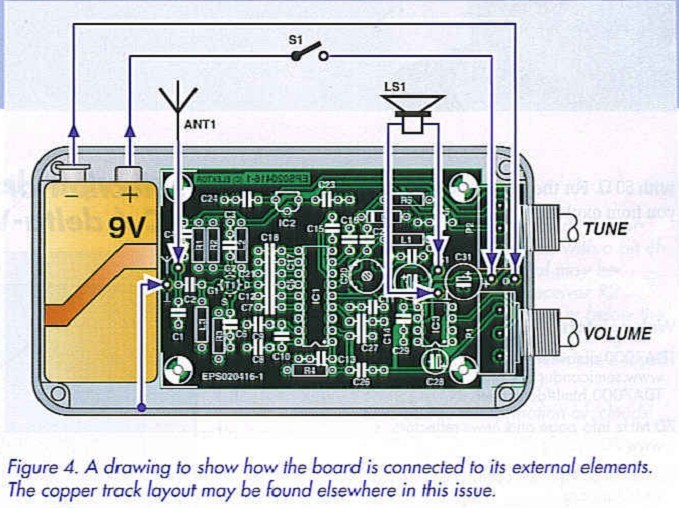

Project Solutions
VHF-Low Explorer (3)
Published:2011/7/28 21:01:00 Author:Phyllis From:SeekIC
By Gert Barrs
Inside the receiver
Figure 3 pictures the circuit diagram of our little receiver. MOSFET Tl at the antenna input provides a gain of about 18 dB across the band, driving the TDA7000 RF input via coupling capacitor C5. The receiver’s input impedance is 50 D to match most types of coax cable available these days. A number of capacitors strewn around the TDA7000 ensure an IF bandwidth of about 70 kHz. The VFO (variable frequency oscillator) inside the chip is tuned by a varicap (Dl) which gets its bias voltage from tuning pot P2. IC2, a 78L05, supplies the regulated 5 volts for the receiver chip, the preamp and, importantly, the tuning pot. 
The circuit configuration around the TDA7000 follows information from Philips on making the chip better compatible with NBFM signals. After all, the TDA7000 was originally designed for reception of VHF FM broadcast stations, which at 100+ kHz deviation are much wider than the ’thin’ PMR signals (3 kHz) we’re interested in. None the less, as the IC will produce a rather low nett output signal, some extra amplification is furnished in the audio section by adding an electrolytic capacitor between pins 1 and 8 of the LM386 AF power amp (another evergreen). Hang on, where are the adjustments and the dreaded home-made coils in this receiver? Well there’s only trimmer C20 to adjust the tuning to 68-88 MHz.
The receiver employs off the shelf miniature chokes only, so there are 0 (say, zero) coils to wind.
Build it
At this point, you should have enough confidence and ’inside knowledge’ about the receiver to start building it, if necessary with the help of a friend with RF experience. If you do not have the means to make your own board, you can easily order a ready-made one through our Readers Services. The board, pictured in Figure 4 together with its external elements, is single-sided with a large copper plane at the solder side to assist in RF stability, screening and decoupling. There are many small ceramic capacitors on the board which need to be positively identified before they are soldered in place. The same goes for the three miniature chokes, the coloured bands on them indicating the value in microhenries. The TDA7000 should be soldered directly on to the board. The 4-legged MOSFET Tl is mounted at the solder side of the board, perched directly onto four solder pads. The close-up photograph in Figure 5 should help to get our message across. 

We would suggest using a small diecast case from Hammond to house the receiver and the battery. The case is then drilled to secure the volume pot, tuning pot and the loudspeaker. Battery powering is not a must however, and you may decide to power the receiver from an existing DC source like a cheap mains adapter. This will require one additional hole to be drilled and filed for the mains adaptor socket.
Caveats and limitations
Due to the simplicity of the design, some inherent limitations should be taken into account. First, the receiver will be found rather susceptible to cross modulation, breakthrough and general interference from nearby FM broadcast transmitters. This not at all surprising in view of the nearby frequencies (89-107 MHz) and power levels in the kilowatts range. Good shielding, coax cable and a tuned antenna for 4 m (see ’Antenna’ inset) should remove most of the interference. Second, a small problem with spurious oscillation was discovered when the receiver’s RF input is not terminated with 50 il For the rest, nothing to stop you from exploring the 4-metres band.
Reprinted Url Of This Article: http://www.seekic.com/blog/project_solutions/2011/07/28/VHF_Low_Explorer__(3).html
Print this Page | Comments | Reading(9442)
Article Categories
New published articles
· Imagination works with TSMC to develop FinFET process
Author:Ecco Reading(33527)
· XMOS pushes event-driven MCUs with lower price
Author:Ecco Reading(3534)
· Intel brings upgraded 32-nm SoC for smartphones
Author:Ecco Reading(3250)
· Micron pushes TLC 128-Gbit NAND flash
Author:Ecco Reading(3816)
· Intel will stop supplying desktop motherboards
Author:Ecco Reading(5341)
· Processor market was expected to regain strength in 2013
Author:Ecco Reading(3318)
· It was reported that TSMC sales fall steeply
Author:Ecco Reading(3474)
· Cisco, NXP work with auto wireless startup
Author:Ecco Reading(3620)
· Micron was impacted by manufacturing glitch
Author:Ecco Reading(4017)
· China can make 22-nm transistor by themselves
Author:Ecco Reading(3820)
· Chip market rebound is coming, according to survey
Author:Ecco Reading(3761)
· Sony, Toshiba will spend more on chips, iSuppli reports
Author:Ecco Reading(3790)
· Qualcomm becomes the 13th company to join NFC Forum board
Author:Ecco Reading(6105)
· TSMC increases building work for FinFET fab
Author:Ecco Reading(3778)
· TI plans to cut 1,700 jobs in OMAP shift
Author:Ecco Reading(4587)